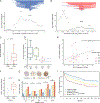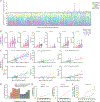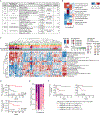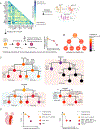Molecular Evolution of Early-Onset Prostate Cancer Identifies Molecular Risk Markers and Clinical Trajectories
- PMID: 30537516
- PMCID: PMC7444093
- DOI: 10.1016/j.ccell.2018.10.016
Molecular Evolution of Early-Onset Prostate Cancer Identifies Molecular Risk Markers and Clinical Trajectories
Abstract
Identifying the earliest somatic changes in prostate cancer can give important insights into tumor evolution and aids in stratifying high- from low-risk disease. We integrated whole genome, transcriptome and methylome analysis of early-onset prostate cancers (diagnosis ≤55 years). Characterization across 292 prostate cancer genomes revealed age-related genomic alterations and a clock-like enzymatic-driven mutational process contributing to the earliest mutations in prostate cancer patients. Our integrative analysis identified four molecular subgroups, including a particularly aggressive subgroup with recurrent duplications associated with increased expression of ESRP1, which we validate in 12,000 tissue microarray tumors. Finally, we combined the patterns of molecular co-occurrence and risk-based subgroup information to deconvolve the molecular and clinical trajectories of prostate cancer from single patient samples.
Keywords: APOBEC; cancer genomics; early-onset cancer; epigenetic risk-score; mutational processes; prostate cancer; structural variants; tumor evolution; tumor evolution prediction.
Copyright © 2018 Elsevier Inc. All rights reserved.
Conflict of interest statement
Declaration of Interests
The authors declare no competing interests.
Figures







Comment in
-
Initiation and Evolution of Early Onset Prostate Cancer.Cancer Cell. 2018 Dec 10;34(6):874-876. doi: 10.1016/j.ccell.2018.11.010. Cancer Cell. 2018. PMID: 30537509
-
Evolutionary and clinical trajectories of early-onset prostate cancer.Nat Rev Urol. 2019 Mar;16(3):145. doi: 10.1038/s41585-019-0144-z. Nat Rev Urol. 2019. PMID: 30610211 No abstract available.
-
Re: Molecular Evolution of Early-Onset Prostate Cancer Identifies Molecular Risk Markers and Clinical Trajectories.J Urol. 2019 Aug;202(2):213-214. doi: 10.1097/JU.0000000000000330. Epub 2019 Jul 8. J Urol. 2019. PMID: 31063059 No abstract available.
References
Publication types
MeSH terms
Substances
Grants and funding
LinkOut - more resources
Full Text Sources
Other Literature Sources
Medical

